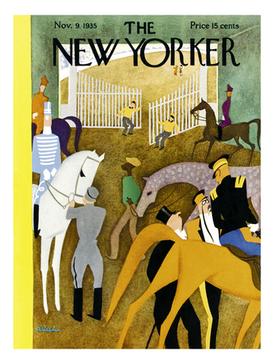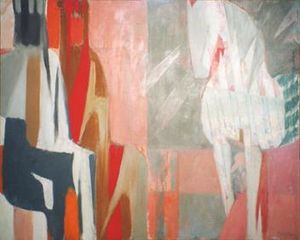Daniel Brustlein facts for kids
Quick facts for kids
Daniel Brustlein ("Alain")
|
|
|---|---|
| Born | September 11, 1904 |
| Died | July 14, 1996 (aged 91) Paris, France
|
| Nationality | Naturalized US |
| Alma mater | École des Arts & Métiers and the École des Beaux-Arts in Geneva, Switzerland |
| Known for | American artist, cartoonist, illustrator, and author of children's books |
Daniel Brustlein (1904–1996) was an American artist. He was born in Alsace, a region in France. He was also a cartoonist, illustrator, and wrote books for children.
He is most famous for his cartoons and cover art. These appeared in The New Yorker magazine. He used the pen name "Alain" from the 1930s to the 1950s. Even famous writer John Updike said Brustlein's cartoons made him want to write for the magazine. Critics also praised his paintings. They said his art showed great skill and control of color.
Contents
Who Was Daniel Brustlein?
His Early Life and Art Training
Daniel Brustlein was born on September 11, 1904. His hometown was Mulhouse, in the Alsace region. Even though the town was part of Germany back then, many people, including Brustlein, felt French.
He started drawing at a young age. When he was just 15, in 1919, he published his first cartoon collection. It was called Petite Histoire de la Guerre en Caricatures. Around that time, he moved to Geneva, Switzerland. There, he studied art at two schools: the École des Arts & Métiers and the École des Beaux Arts.
In 1924, one of his teachers told him to move to Paris. He found work as an illustrator there. He also kept studying art. Some of his illustrations were shown in a big art show in Paris in 1925. This show helped introduce the Art Deco style.
Moving to New York City
In 1927, Brustlein moved to New York City. He got advice from a friend, Jean Coquillot, who was also an artist. Coquillot had moved from Geneva earlier and found work as an illustrator.
Through his friend, Brustlein started drawing illustrations and cartoons. Within a few years, he became a regular artist for The New Yorker magazine.
His Artistic Style and Work
Brustlein's unique style really developed after he moved to New York. This is when he started working as an illustrator and cartoonist.
Cartoons and Magazine Art
In the early 1930s, his cartoons began appearing in The New Yorker and Collier's magazines. He always signed this work with the name "Alain." He used this pen name for all his cartoons and illustrations.
His first cover art for The New Yorker was on November 9, 1935. Over the next 30 years, he created nine more covers for the magazine. In 1936, he illustrated a book called Farewell to Model T. This book was written by New Yorker writer E. B. White.
During World War II, Brustlein drew cartoons to help the war effort. In 1942, he won first prize for a cartoon in an exhibition. This show raised money for war bonds. Another cartoon of his, showing a Japanese husband reading a newspaper, also won a prize. It was part of a show called "Cartoons Against the Axis."
In July 1942, Brustlein married the painter Janice Biala. After the war, they moved to Paris. They lived there most of the year but kept their American citizenship. They usually spent some months in the United States.
After the war, Brustlein continued to make cartoons and covers for The New Yorker. But he started doing less of this work. He wanted to spend more time on his paintings and illustrating children's books. One of his cartoons from 1955 is famous for being clever. It shows art students in ancient Egypt drawing a model using modern art techniques.
His Paintings and Other Art
Besides magazines, Brustlein was also a painter and book illustrator. After World War II, he started showing his paintings. He had group and solo exhibitions in New York, Paris, and other cities.
In 1952, he had his first solo show in Paris. A French art critic even called him one of the best young painters of the day. In 1955, he had his first solo exhibition in New York.
In 1960, Brustlein won an award for a painting. This painting, a self-portrait, appeared on the cover of ARTnews magazine. Four years later, his brother-in-law, Jack Tworkov, wrote an article about him in the same magazine.
Critics often praised Brustlein's paintings. They noted his "great refinement" and "beautiful control" over emotions in his art. They also admired his use of "gentle and delicate" colors. He continued to show his art in galleries throughout the 1970s and 1980s.
In 1994, there was a special exhibition called "A Family." It showed Brustlein's works alongside art by his wife and her family members.
Books for Young Readers
Brustlein illustrated a book in the 1930s. But in the mid-1950s, he started writing and illustrating his own books. Most of these were short books for children.
- In 1956, he wrote and illustrated The Elephant and the Flea. It's about an elephant trying to get rid of a flea.
- That same year, he illustrated It's Spring! It's Spring!, written by his wife. A reviewer said his drawings were "wonderfully colored."
- In 1957, he wrote and illustrated The Magic Stones. This book teaches about how arches are used in buildings. It explains how medieval builders used arches to build great cathedrals like Notre-Dame de Paris.
- In 1959, he illustrated Minette, another book by his wife. It's about a cat's life in a royal palace.
- In 1968, Brustlein wrote and illustrated One, Two, Three, Going to Sea. This book uses cartoon figures to help kids learn adding and subtracting. Reviewers called it both fun and helpful for children learning math.
His Life and Family
Brustlein was born in Mulhouse, a town near the borders of Germany, France, and Switzerland. The town's nationality changed several times throughout history. When asked about his nationality at birth, Brustlein always said he was French.
He studied art in Geneva, Switzerland. He likely became a Swiss citizen there. When he moved to New York in 1927, his ship's records listed him as Swiss. He became a U.S. citizen in 1933.
In 1942, Daniel Brustlein married the painter Janice Biala. They were both artists and loved French culture. They were friends with many artists in Paris and New York. One of their close friends was Willem de Kooning, who later became a very famous artist.
They lived in New York during World War II. In 1947, they moved to Paris. They also bought a farmhouse in New Jersey for their visits to the United States.
Daniel Brustlein passed away on July 14, 1996, at the age of 92. His wife, Janice Biala, passed away four years later.



